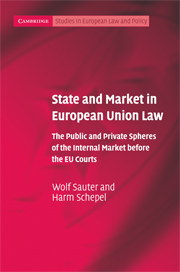 State and Market in European Union Law
State and Market in European Union Law Published online by Cambridge University Press: 22 January 2010
Introduction
Above, we have discussed the free movement and competition rules separately, focusing on how the scope of these respective rules is determined in relation to the addressees for which they were originally intended – i.e. free movement for Member States and competition rules for undertakings. This showed that the Court tends to apply a functional approach to formal categories of public bodies and undertakings. As illustrated by the functional approach to the concepts of ‘public bodies’ and ‘undertaking’, the net result is that the competition rules can be applied to ‘public authorities’ and the free movement rules to private parties. More recently, however, the Court's functionalism is increasingly qualified by subsidiarity and pre-emption. The nature of the constraints that follow from this development, and their limits, will now be elaborated.
The focus of this chapter is on the cross-cutting application of the free movement and competition rules. This discussion is organised in four main parts dealing with the following topics:
– the application of the free movement rules to private parties;
– the application of the competition rules to State measures;
– when behaviour should be attributed to the State, and when to undertakings;
– the relationship between the free movement and the competition rules directly.
As before, the main questions remain: how (i.e. according to which criteria) the Court attributes measures to either the public or private sphere; how it establishes whether the free movement and competition rules are applicable; and how it decides whether public interest exceptions and/or justifications apply, and what their scope is.
To save this book to your Kindle, first ensure [email protected] is added to your Approved Personal Document E-mail List under your Personal Document Settings on the Manage Your Content and Devices page of your Amazon account. Then enter the ‘name’ part of your Kindle email address below. Find out more about saving to your Kindle.
Note you can select to save to either the @free.kindle.com or @kindle.com variations. ‘@free.kindle.com’ emails are free but can only be saved to your device when it is connected to wi-fi. ‘@kindle.com’ emails can be delivered even when you are not connected to wi-fi, but note that service fees apply.
Find out more about the Kindle Personal Document Service.
To save content items to your account, please confirm that you agree to abide by our usage policies. If this is the first time you use this feature, you will be asked to authorise Cambridge Core to connect with your account. Find out more about saving content to Dropbox.
To save content items to your account, please confirm that you agree to abide by our usage policies. If this is the first time you use this feature, you will be asked to authorise Cambridge Core to connect with your account. Find out more about saving content to Google Drive.